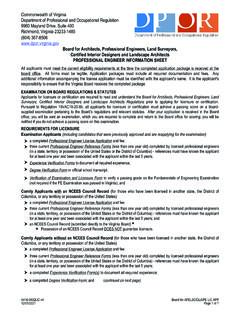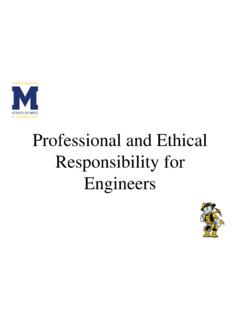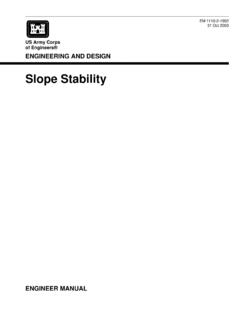Transcription of Engineer’s Seal
1 CONTRIBUTORS Brian Ross, Gartenburg, Khalil, Qureshi, Peter R sch, Vera, Whang, Use of the Professional engineer s Seal March 2022 Guideline for Use of the Professional engineer s SealCONTENTS1. Purpose of PEO Guidelines ..42. Preface ..43. Purpose and Scope of this Guideline ..44. Introduction ..45. Authority and Jurisdiction ..56. Purpose of the Professional engineer s Seal ..57. Recommended Procedures for Use of the Professional engineer s Seal ..6 General considerations ..5 Overview ..5 The seal ..6 What to seal ..6 What not to seal ..6 Exceptions from sealing requirements ..6 Who seals ..7 Procedure ..7 Purpose of the engineering document ..7 One practitioner assumes professional responsibility .
2 8 Multiple practitioners assume professional responsibility ..8 Revising sealed documents ..8 Shop drawings ..8 Shop drawings with application-specific engineering content ..8 Shop drawings without application-specific engineering content ..8 Conformance review of shop drawings ..8 Typical detail drawings ..9 Component drawings ..9 Preferred detail drawings ..9 As-built and record documents ..9 Reliance on sealed documents ..9 Engineering documents containing more than one language ..9 Intellectual property issues ..92 Assuming responsibility and Supervising Engineering Work Notice: The Professional Standards Committee periodically reviews guidelines to determine if the guideline is still viable and adequate. However, practice bulletins may be issued from time to time to clarify statements made herein or to add information useful to those practitioners engaged in this area of practice.
3 Users of this guideline who have questions, comments or suggestions for future amendments and revisions are invited to submit these to the Guideline Amendment and Revision Submission Form: Management of Sealed Documents ..10 Assuming responsibility for engineering documents ..10 Control of sealed documents ..10 Use and control of sealed electronic documents ..10 Digital signature software solutions ..119. Professional responsibility ..11 What is professional responsibility ? ..11 Assuming responsibility for work performed by others ..12 Penalty for misuse of seal ..12 Ownership and replacement of seal ..12 10. Managing Disagreements on Whether a Document Should Be Sealed ..12 Appendix ..13 Appendix 1 Definitions ..13 Appendix 2 Extracts from Regulation 941, Professional Engineers Act.
4 13 Professional Engineers Ontario 34 Guideline for Use of the Professional engineer s SealPURPOSE AND SCOPE OF THIS GUIDELINE The purpose of this guideline is to provide practitioners with guidance on the proper use of the professional engineer s seal. The seal on engineering documents signifies that a practitioner assumes professional responsibility for the specified intent of the documents. Proper use of the seal is important for complying with the Act. Consequently, the application of the seal should be done only after the practitioner has evaluated documents and accepts responsibility for that references in this guideline to practitioners means holder of a licence, a temporary licence, a provisional licence, a limited licence or a certificate of authorization issued in the province of Ontario under the Act, as the case This guideline provides best practices and the requirements for use of the professional engineer s seal.
5 It provides a framework for practitioners to resolve issues that arise in common practice situations. Practitioners have often asked PEO to clarify, for example, what changes to sealed documents are allowed, and how the changes should be identified. Others have asked whose seal should appear when more than one practitioner has been respon-sible for preparing documents. The subcommittee reviewed several common situations to provide best practice guidance that expands upon the requirements in section 53 of Regulation the use of digital documents, including their use for legal purposes, has become widespread, PEO recognized the need to provide additional guidance on creating, applying and con-trolling digital seals and signatures. Furthermore, digital copies of documents are often required for submission purposes; these require digital seals and signatures.
6 This guideline, therefore, provides new best practice guidance to address the use of seals on digital OF PEO GUIDELINES Professional Engineers Ontario (PEO) produces guidelines to educate licensees and the public on best more information on the purpose of practice guidelines, the guideline development and maintenance processes, including the Professional Engineers Ontario (PEO) standard form for propos-ing revisions to guidelines, please read our document Guideline Development and Maintenance view a list of the PEO guidelines, please visit the Practice Guidelines section of the PEO website: In September 2016, PEO Council approved the formation of a subcommittee of the Professional Standards Committee (PSC) comprised of practising professional engineers and tasked this group with proposing amendments to the use of seal regulations and revising the existing Use of the Professional engineer s Seal practice guideline.
7 The PSC directed the subcommittee to provide additional clarity regarding the obligations of practitioners sealing documents, and to address issues involving the seal and new technologies, such as digital files, which eliminate the need for conventional two-dimensional subcommittee met for the first time on May 10, 2017. Following a public consultation and an external legal review the subcommittee submitted a completed draft of this document to the PSC for approval on December 14, the approval from the PSC, the final draft was approved by Council at its meeting on February 18, guideline is to be read in conjunction with recent amend-ments dated July 1, 2022, to section 53 of Regulation 941 made under the Professional Engineers Act (the Act),1 which describe the statutory requirements for the use of the seal.
8 Appendix 2 has a copy of these final 1990, c. Professional Engineers Ontario 5 AUTHORITY AND JURISDICTION The requirement to seal is addressed in the Act. The decision in Assn. of Professional Engineers (Ontario) v. Ontario (Minister of Municipal Affairs & Housing)2 confirmed PEO s exclusive authority to regulate practitioners. Furthermore, the Act gives PEO authority to make regulations requiring and governing the signing and sealing of documents and designs by members of the Association, holders of temporary licences and holders of limited licences, specifying the forms of seals and respecting the issuance and ownership of seals. 3 Consequently, the practitioner is the one who must determine whether a document can be reasonably viewed as containing engineering content and thereby needs to be sealed and should refer to the policies and procedures in this document for guidance in making that Act is Ontario law.
9 Therefore, it follows that when the Act refers to public welfare it refers to the public in Ontario. Fur-thermore, as noted in the Professional Engineering Practice guide-line, in most situations a person requires a licence issued by PEO to practise professional engineering in Ontario. Consequently, it is reasonable to conclude that the use of seal requirements apply to practitioners assuming responsibility for engineering documents for specific engineering projects located in OF THE PROFESSIONAL The seal must be used to identify all work where a practitioner either prepared a document or assumed responsibility for any portion of the document s engineering content. The purpose of the seal is specified in section 53(2) of Regulation 941:(2) A practitioner shall, subject to subsections (7) and (8), sign, date and affix their seal to an engineering document if, (a) t he document s engineering content is prepared by the practitioner; or (b) the practitioner otherwise assumes responsibility for any part of the document s engineering content.
10 Assuming responsibility means the practitioner could be held accountable in the event of professional misconduct or incompe-tence regarding the engineering work as per sections 28(2) and 28(3) of the Act. Consequently, a reasonably prudent practi-tioner must review or supervise work for which they will assume responsibility , unless they prepared the work themselves. For more information, practitioners should refer to PEO s practice guideline Assuming responsibility and Supervising Engineering seal by itself is not a guarantee by a practitioner of a successful outcome of a project, since the outcome in part depends on factors beyond the control of a practitioner. The seal is not, and should not be considered, a certification mark or warranty of correctness.









